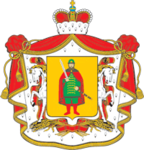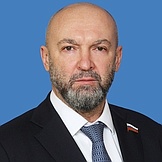Regional flags and emblems


PROFILE
Established 26 September 1937
Capital Ryazan
The Ryazan Region is part of the Central Federal District
Area 39,600 sq km
Population 1 074 000 (2025)
Ethnic groups
(2020 National Census, %)
Russian – 94,57
Other – 5,43
Administrative divisions (2024)
Municipal districts – 22
City districts – 3
Rural towns – 28
Rural districts – 206
Geography and climate
The Ryazan Region is located in the central part of the East European Plain. It borders on the Republic of Mordovia, as well as the regions of Penza, Tambov, Lipetsk, Tula, Moscow, Vladimir and Nizhny Novgorod.
The main rivers flowing through the region are the Oka with its tributaries, Vozha, Moksha, Tsna, Para, Pronya, Ranova, Pra, Gus and other tributaries related to the Don River basin.
There are the Novomichurinsk Reservoir on the Pronya River and over 2,800 lakes, with Lake Velikoye being the largest. There are several karst lakes such as Beloye.
The local climate is moderate continental. The average temperature in January is –10°С and in July 20°С. The average annual precipitation is 500 mm, including 25% to 30% snow. The agroclimatic conditions are irregular and change from the north to the south. They are also affected by terrain, landscape, soil type and other natural and local specifics.
The region has the Oka Nature Biosphere Reserve, Meshchyora National Nature Park.
Government
The legislative branch is represented by the Ryazan Region Duma, which is the permanent, representative and only body of legislative authority in the region. The Ryazan Region Duma has 40 deputies, with 20 of them running in single-mandate constituencies and the other 20 in the single electoral district, where winners are identified in proportion to the number of votes cast for lists of candidates nominated by electoral associations.
The current Ryazan Region Duma was elected in September 2020. The term expires in September 2025.
The executive branch in the Ryazan Region is represented by the Governor of the Ryazan Region, the Government of the region and other executive agencies in the region. The Government of the Ryazan Region is the supreme and permanent body of executive authority in the region.
The Governor of the Ryazan Region is the region’s highest-ranking official who heads the supreme executive body of the Ryazan Region – the Government of the Ryazan Region and leads the executive branch in the Ryazan Region. The Governor is elected for five years by Russian citizens who permanently reside in the region. The term of office of the current incumbent expires in September 2027.
Economy and natural resources
The Ryazan Region is the center of European Russia, with a developed transport, energy and telecommunications infrastructure. The region has a great production and workforce potential. Locally produced goods are in steady demand on both domestic and foreign markets.
Industrial production is the main economic sector in the Ryazan Region, accounting for about one third of the regional GDP. Oil refining, machinery, metal processing, electricity, chemicals, construction as well as food and the manufacturing of consumer goods, ferrous and non-ferrous metals and building industry are developing in the region.
The region is home to some of Russia’s major electronics producers, including radio equipment and machinery. Many local companies have modern technology to produce key industrial products, including electricity, oil products, cement, soft roofing and insulation material, equipment for oil drilling and extraction, geological survey, forging and electric welding, metal-cutting machines, vacuum tube devices, industrial lighting, computing and medical equipment, car components and mechanisms, trailers and semi-trailers for lorries, street and public services machinery, non-ferrous metals, limestones and bricks, chrome-tanned leather goods, textiles, clothes and shoes, food, chemicals and pharmaceuticals.
The Ryazan Region’s energy potential allows the annual production of three times more electricity than the region actually consumes.
Transport is a big aspect of the local socioeconomic development. Roads are the most important part of the regional transport system. The region’s roads stretch to a total of 11,000 km. The railway and road network consists of four main railways (Moscow, Southeastern, Gorky and Kuibyshev) and three federal motorways (M5 Urals from Moscow to Chelyabinsk, M6 Caspian from Moscow to Astrakhan and 1Р-132 connecting Kaluga, Tula, Mikhailov and Ryazan). The main water artery, the Oka, connects the Ryazan Region with the Moscow, Vladimir and Nizhny Novgorod regions. It also flows into the Volga River basin and, via channels, reaches the White, Baltic, Black and Caspian seas. There is a river terminal in Ryazan and an interregional transit terminal based at warehouse facilities.
Agriculture accounts for over 8% of the regional GDP. The sector specialises in livestock breeding and produces milk, meat, wool and eggs. There are also large vegetable, potato and grain suppliers. The agriculture sector almost covers the demands of the region’s population for the main agricultural products except meat.
As of today, the agro-industrial sector accounts for almost a quarter of the total investment in the region’s economy. The bulk of investment goes to dairy stock and pig farming, in particular, the region continues to implement major projects to build livestock farming complexes in the districts of Rybnoye, Zakharovo and Alexandro-Nevsky.
Culture and tourism
The Ryazan Kremlin is the main Ryazan landmark. The Kremlin, built between the 15th and19th centuries, includes a complex of 17th-century civil buildings. The landmarks in the Kremlin have been under renovation for the last 20 years, and now many of them have been restored back to how they originally looked. The Ryazan Kremlin includes 18 architectural, historical and cultural landmarks built between the 11th and 19th centuries, where the Singers’ Building of the Episcopal Chamber (1658), the Cathedral of the Assumption (1693−1699) and the Cathedral of the Nativity (15th−19th centuries) should be singled out.
The Ground Walls of the Old Ryazan (dating back to the 12th and 13th centuries) is another grand ancient landmark that has survived until today as is the Solotchinsky Monastery founded by Prince Oleg in 1390.
John the Evangelist’s Monastery in Poshchupovo, on the right bank of the Oka River, founded by missionary monks between the 12th and 13th centuries is another famous monastery of the region with its main relic, John the Evangelist’s miracle-working icon brought from Constantinople. For many people, the Ryazan Region is connected with a great Russian poet, Sergei Yesenin. There is the Yesenin State Museum Reserve in Konstantinovo, where the poet was born.
Other landmarks include academician Ivan Pavlov’s museum estate, the Old Ryazan historical and archeological reserve, the Museum of Airborne Troops, Konstantin Tsiolkovsky Museum, a museum of wooden architecture in the Lunkino village, a narrow-gauge railway, and the famous Ryazan crafts, such as Mikhailovo lace, Skopin ceramics as well as Kadom Venise embroidery.
The Oka Nature Biosphere Reserve located 120 kilometres away from Ryazan is a good place to see the nature of southeastern Meshchyora. There is a crane nursery: the only place in Russia where all species of Russian cranes can be seen at the same time. The Meshchyora National Park was established in 1993 in order to protect and restore unique natural complexes. In total, the park has eight natural landmarks, eight sanctuaries together with over 100 archeological landmarks.
It is possible to hunt and fish in the region for almost entire year. All the conditions for amateur and recreational fishing has been created on the Oka, Pronya, Ranova and Pra rivers as well as at numerous reservoirs and lakes. There are special highly popular hunting tours; “Russian hunting” with hounds.


